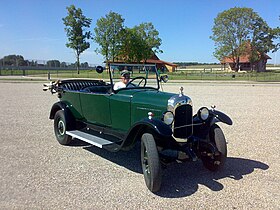Citroën Type B12
| Citroën Type B12 10CV | |
|---|---|

Citroën B12 with "Torpedo" bodywork
|
|
| Overview | |
| Manufacturer | Citroën |
| Production | 1925-1927 38,381 produced |
| Body and chassis | |
| Body style |
"Torpedo" "Conduite Intérieure" (saloon/sedan) Cabriolet Torpédo commercial Coupé de ville |
| Layout | FR layout |
| Powertrain | |
| Engine | Petrol/gasoline: 1,452cc Straight-4 |
| Transmission | 3-speed manual |
| Dimensions | |
| Wheelbase | 2,830 millimetres (111.4 in) |
| Length | 4,000 millimetres (157 in) |
| Chronology | |
| Predecessor | Citroën Type B10 |
| Successor | Citroën Type B14 |
The Citroën B12 was an automobile produced by Citroën at André Citroën's factory in central Paris, and available for public sale between October 1925 and January 1927. 38,381 were produced.
Major competitors included the Peugeot 177 and the Renault KZ.
The B12 was manufactured using modern mass production technologies which in France at the time, were still unique to Citroën. It also used "all-steel" ("tout-acier") bodies for its two most popular body types.
First displayed at the Paris Motor Show in October 1925, the Citroën B12 shared its chassis and engine with the B10, which it replaced.
The size of the 4-cylinder engine remained at 1,452 cc, and as with the earlier model, the B12 was sometimes known as the Citroën 10HP (or 10CV), the HP in the suffix being a reference to its fiscal horsepower, a number computed according to the cylinder diameters and used to define its taxation class.
A range of body types was listed, although most of the cars came with "Torpedo" type or "Conduite Intérieure" (two-box saloon/sedan) bodies. Other body types listed were a cabriolet, a "Torpédo commercial" and something called a "Normande".
The B10 had been the manufacturer's (and Europe's) first production car comprising an all-steel body. Its replacement -- the B12 -- was the second. This approach garnered much positive reaction in an age that valued innovation, but the B10 itself had forced the manufacturer onto a very steep learning curve, which unfortunately had been shared by customers. The B10 had been insufficiently rigid. Once the car got moving, the body had twisted and flexed, causing sections of bodywork to become detached and doors to open spontaneously. The B10 had inherited its chassis from the B2, but it was quickly apparent that a stronger and stiffer chassis would be needed to complement the necessary rigidity of an all-steel car body.
...
Wikipedia
